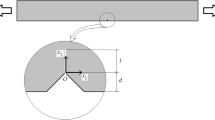Abstract
Crack growth in transformable ceramics is studied using a finite element approach. In the analysis, a continuum theory is used for the description of the inelastic deformation due to a stress-induced martensitic type phase transformation with both dilatation and shear strain components. Attention is focussed on materials in which the transformable phase is not distributed homogeneously, as is the case in, for example, most ZTA materials and Duplex Ceramics. In this paper, the distribution of transformable phase is assumed to be symmetric with respect to the crack plane; in the companion paper [1] this assumption is left. The effect of the heterogeneity on the toughness is studied in detail. A small scale boundary value crack problem is formulated and an incremental loading algorithm with a nodal release technique is used to simulate crack advance. It is found that in all cases studied the maximum toughness improved relative to homogeneous materials with the same average volume fraction of zirconia. The results are presented in plots of transformation zones and crack-growth resistance curves.
Similar content being viewed by others
References
G.Th.M.Stam and E.van derGiessen, Crack growth in non-homogeneous transformable ceramics. Part II: Crack deflection, International Journal of Fracture 79 (1996) 273–293.
A.G.Evans and A.H.Heuer, Journal of the American Ceramics Society 63 (1980) 241–248.
D.J.Green, R.H.J.Hannink and M.V.Swain, Transformation Toughening of Ceramics, CRC Press, Boca Raton, Florida, USA (1991).
M.Rühle, N.Claussen and A.H.Heuer, Journal of the American Ceramics Society 69 (1986) 195–197.
E.H.Lutz and N.Claussen, Journal of the American Ceramics Society 74 (1991) 11–18.
A.G.Evans, N.Burlingame, M.Drory and W.M.Kriven, Acta Metallurgica 29 (1981) 447–456.
B. Karihaloo, in Structural Ceramics Processing, Microstructure and Properties., J.J. Bentzen et al. (eds.), Riso, Denmark (1990) 359–364.
P. Den Exter, Synthesis, Microstructure and Mechanical Properties of Zirconia—Alumina Composites. Ph.D. thesis, Enschede, The Netherlands (1991).
Q.P.Sun, K.C.Hwang and S.U.Yu, Journal of Mechanics and Physics of Solids 39 (1991) 507–524.
R.M.McMeeking and A.G.Evans, Journal of the American Ceramics Society 65 (1982) 242–246.
B.Budiansky, J.W.Hutchinson and J.C.Lambropoulos, International Journal of Solids and Structures 19 (1983) 337–355.
P.E.Reyes-Morel and I.W.Chen, Journal of the American Ceramics Society 71 (1988) 343–353.
I.W.Chen and P.E.Reyes-Morel, Journal of the American Ceramics Society 69 (1986) 181–189.
G.Th.M.Stam, E.Van derGiessen and P.Meijers, International Journal of Solids and Structures 31 (1994) 1923–1948.
G.Th.M. Stam and E. Van der Giessen, in Fracture Mechanics; 25th volume, ASTM STP 1220, F. Erdogan and R.J. Hartranft (eds.), Philadelphia, USA (1995) 3–18.
G.Th.M.Stam, E.Van derGiessen and P.Meijers, Materials & Design 14 (1993) 83–86.
M.Rühle, A.Strecker, D.Waidelich and B.Kraus, Journal of the American Ceramics Society 12 (1984), 256–274.
M.Rühle and A.G.Evans, Progress in Material Science 33 (1989) 85–167.
A.G.Evans and R.M.Cannon, Acta Metallurgica 34 (1986) 2435–2441.
J.D. Eshelby, Progress in Solid Mechanics II, I.N. Sneddon and R. Hill (eds.) (1961) 89–140.
T.Mori and K.Tanaka, Acta Metallurgica 21 (1973) 571–574.
G.Th.M. Stam, A Micromechanical Approach to Transformation Toughening in Ceramics, Ph.D. thesis, Delft University of Technology (1994).
J.W. Hutchinson, Harvard University Report TR74-1042 (1974).
J.C.Lambropoulos, International Journal of Solids and Structures 22 (1986) 1083–1106.
C.L.Hom and R.M.McMeeking, International Journal of Solids and Structures 30 (1990) 1211–1223.
G.Th.M.Stam and E.Van derGiessen, Mechanics of Materials 21 (1995) 51–71.
H.E.Lutz and N.Claussen, Journal of the European Ceramics Society 7 (1991) 209–218.
H.E.Lutz and N.Claussen, Journal of the European Ceramics Society 7 (1991) 219–226.
Author information
Authors and Affiliations
Rights and permissions
About this article
Cite this article
Stam, G., Van Der Giessen, E. Crack growth in non-homogeneous transformable ceramics. Part I: Constrained straight cracks. Int J Fract 79, 249–271 (1996). https://doi.org/10.1007/BF00019380
Received:
Accepted:
Issue Date:
DOI: https://doi.org/10.1007/BF00019380




